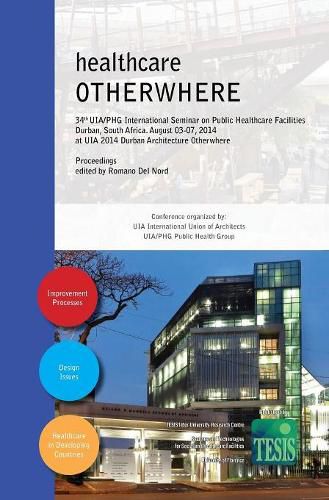Readings Newsletter
Become a Readings Member to make your shopping experience even easier.
Sign in or sign up for free!
You’re not far away from qualifying for FREE standard shipping within Australia
You’ve qualified for FREE standard shipping within Australia
The cart is loading…






This title is printed to order. This book may have been self-published. If so, we cannot guarantee the quality of the content. In the main most books will have gone through the editing process however some may not. We therefore suggest that you be aware of this before ordering this book. If in doubt check either the author or publisher’s details as we are unable to accept any returns unless they are faulty. Please contact us if you have any questions.
This volume documents the results of the 34th UIA/PHG International Seminar on Public Healthcare Facilities held in Durban, South Africa, 3-7 August 2014, as part of the more extensive conference entitled architecture OTHERWHERE, XXV International Union of Architects World Congress “ organized by UIA. The volume is divided into three sessions containing the contributions of members of the UIA/PHG at the conference. The volume opens with the first session entitled ‘'Planning, Design and Construction Improvement Processes” with a look towards the future, outlining the possible fields of investigation in the area of health planning research and reflecting on the results and dissemination of design approaches such as Evidence-Based Design and Open Buildings. The second session “Design Issues for Healthcare Buildings” provides an overview of design solutions that improve the quality of life of users at all stages of life, from birth to old age. The excursus leads to a reflection on how it is essential for care environments to be safe and ahead of the new technologies, while at the same time they should take into account the social and psychological sphere of patients, family members and staff who attend the facility. The third session “Planning and Design Healthcare in Developing and Newly Industrialized Countries” outlines a broad framework of initiatives and activities designed and implemented in developing countries. The situation described emphasizes the important role of the designer in the construction of new buildings and the guidelines for interventions to improve the buildings system, moreover as a researcher a designer can analyze the needs of the local population as well as document the de facto state of existing buildings. The volume is the fourth in a series of UIA/PHG proceedings edited by TESIS, Inter University Research Center - University of Florence, Italy, and it was produced in close collaboration with the CSIR, Council of Scientific and Industrial Research in South Africa, program coordinator of the Public Health Group in the 2014 UIA conference.
$9.00 standard shipping within Australia
FREE standard shipping within Australia for orders over $100.00
Express & International shipping calculated at checkout
This title is printed to order. This book may have been self-published. If so, we cannot guarantee the quality of the content. In the main most books will have gone through the editing process however some may not. We therefore suggest that you be aware of this before ordering this book. If in doubt check either the author or publisher’s details as we are unable to accept any returns unless they are faulty. Please contact us if you have any questions.
This volume documents the results of the 34th UIA/PHG International Seminar on Public Healthcare Facilities held in Durban, South Africa, 3-7 August 2014, as part of the more extensive conference entitled architecture OTHERWHERE, XXV International Union of Architects World Congress “ organized by UIA. The volume is divided into three sessions containing the contributions of members of the UIA/PHG at the conference. The volume opens with the first session entitled ‘'Planning, Design and Construction Improvement Processes” with a look towards the future, outlining the possible fields of investigation in the area of health planning research and reflecting on the results and dissemination of design approaches such as Evidence-Based Design and Open Buildings. The second session “Design Issues for Healthcare Buildings” provides an overview of design solutions that improve the quality of life of users at all stages of life, from birth to old age. The excursus leads to a reflection on how it is essential for care environments to be safe and ahead of the new technologies, while at the same time they should take into account the social and psychological sphere of patients, family members and staff who attend the facility. The third session “Planning and Design Healthcare in Developing and Newly Industrialized Countries” outlines a broad framework of initiatives and activities designed and implemented in developing countries. The situation described emphasizes the important role of the designer in the construction of new buildings and the guidelines for interventions to improve the buildings system, moreover as a researcher a designer can analyze the needs of the local population as well as document the de facto state of existing buildings. The volume is the fourth in a series of UIA/PHG proceedings edited by TESIS, Inter University Research Center - University of Florence, Italy, and it was produced in close collaboration with the CSIR, Council of Scientific and Industrial Research in South Africa, program coordinator of the Public Health Group in the 2014 UIA conference.